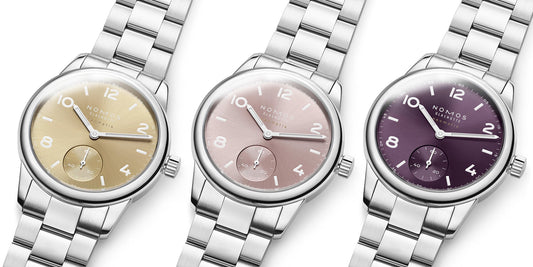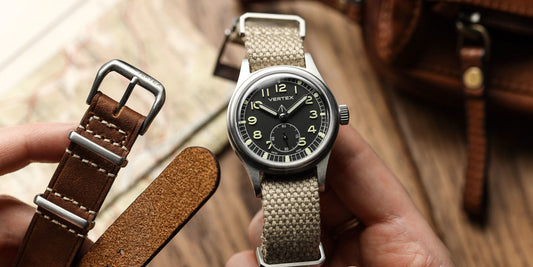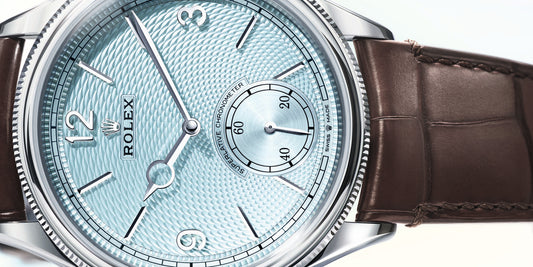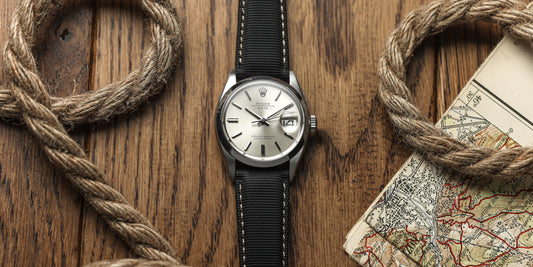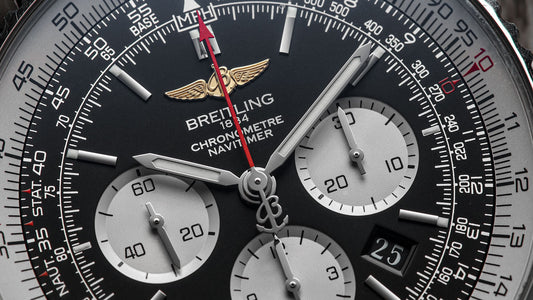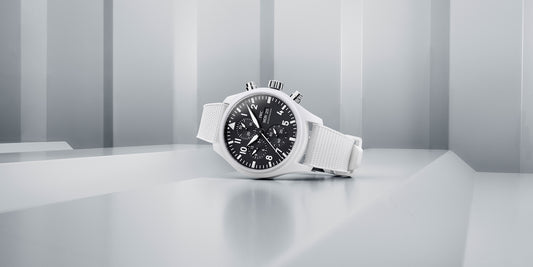Has anyone else noticed the recent rise in moon phase watches made with sparkly dark blue, aventurine dials? It is a marriage that makes perfect sense; aventurine glass embodies the night sky, and the moon looks most at home there. The allure of these celestial-inspired timepieces has not gone unnoticed, by us or our readers, so we thought we’d explore these aventurine-decorated moonphase watches in more detail and handpick some of our personal favourites.




The world of horology is always pushing the boundaries of design and functionality, but there are certain design elements that will forever remain a steadfast classic. One of those is the moonphase complication. The first moonphase watches can be traced back to the 17th century, a period known by many as the Golden Age of watchmaking. Early watchmakers like Christiaan Huygens and Nicolaus Mercator are often credited for developing some of the first mechanisms necessary for accurately displaying the phases of the moon.
The first moonphase watches were pocket watches, and they became invaluable tools for sailors and navigators in the age of exploration. Knowing the phases of the moon helped in determining tides and lunar positioning, aiding in navigation during sea voyages. Nowadays, moonphase watches are more appreciated for their aesthetics. Sure, knowing the current phase of the moon is fun and the complication looks extremely romantic and pretty, but their practicality is a little more limited. That doesn’t make them any less popular, however.
The Aventurine Dial
 Credit Bucherer and H. Moser & Cie
Credit Bucherer and H. Moser & Cie
You’ve probably noticed it too, but there’s been more aventurine used in watchmaking than usual. Interestingly, it’s believed aventurine glass was first discovered during the 17th century too, in Murano, Venice. The shimmering material gets its sparkle from the presence of mineral inclusions, or chrome-bearing fuchsite, which is often mica (often green) or hematite (with a reddish-brown hue).
Aventurine can form naturally when these mineral inclusions become suspended within molten quartz during crystallisation. In other cases, aventurine is created intentionally by introducing small flakes or other reflective minerals into molten quartz. In both instances, it leaves the stone with a fascinating sparkle and one that quite clearly resembles a star-studded sky.

Over the last few years, there’s been an increasing number of watchmakers utilising this sparkly glass, typically placing it onto the dials of watches. The Louis Erard Excellence Petite Second Aventurine is one that always come to my mind, pairing the dark blue shimmering display with a snailed small seconds counter and glossy silver hardware. More recently, we also welcomed a collaboration between Bucherer and H. Moser & Cie who combined the stone with a tourbillon mechanism. This is another complication that works well with a sparkly blue backdrop.
We also can’t move on without mentioning the Geckota Pioneer Midnight Sky watch. For the first time, Geckota has taken the space-age design of the Pioneer case and reflected deep space in the dial. The glittering dark blue aventurine dial beautifully reflects the constellations you can see during a clear winter’s night. It’s also the first Pioneer with a smaller 39mm case and it features redesigned hands to attract audiences of every gender. It’s my personal favourite Geckota Pioneer in the entire collection.
Moonphase & Aventurine – The Perfect Match?
So, with the rise of aventurine in watchmaking, it seems only right that this night sky-evoking glass should be paired with the moonphase complication. And lo and behold, there is no shortage of watchmakers doing just that. I could be totally wrong here so scold me in the comments if I am, but I believe the Arnold & Son HM Perpetual Moon watch was one of the first watches in recent years to combine the sparkly blue glass with a moonphase window. It’s an incredibly stunning watch, boasting a gigantic 29mm wide moonphase aperture at 12 o’clock, looming over the blue aventurine dial. It’s an incredibly realistic interpretation of a night sky on a dial.




More recently, Christopher Ward launched their own interpretation of the “moonphase aventurine” watch. They did another fantastic job of bringing to life a realistic image of the moon in the night sky, using aventurine as the backdrop and a four-colour representation of the moon in Globolight, a material that is a mix of ceramic and Superluminova. Although I still have some questions regarding the audience of the Christopher Ward C1 Moonphase since the case size – especially the height of 13.3mm – feels a little oversized for a watch of this style – there is no doubt the dial is still beautifully executed and the realism of the moon in particular is stunning.
Finally, we have to mention the Omega Moonphase Co-Axial Master Chronometer Moonphase Chronograph. All the watches we’ve mentioned so far have been undeniably dressy in their aesthetics whereas this Omega, while still certainly worthy of a formal occasion, has a sportier personality. Omega have cleverly dressed up their Speedmaster case with blue ceramic, aventurine and rose gold accents on the dial and bezel, but with its protruding pushers and chronograph complication, it’s certainly an interesting clash of materials and complications.
In Conclusion

I have no doubt that the aventurine dial is here to stay, especially when paired with the moonphase complication. Resembling a starry night’s sky, it naturally compliments the celestial theme of the moonphase; the tiny mineral inclusions mimic the twinkle of stars and imitate gazing at a clear sky at night from the wrist. Both the material and complication also require plenty of precise craftsmanship and artistry which alone makes owning one of these timepieces a pleasure.
I think there’s also good reason we’re seeing so many aventurine moonphase watches at this time of year. Wearing a watch like this certainly feels fitting with the darker, colder nights of winter. Plus, there’s something seriously festive about a sparkly watch dial. If I owned one, an aventurine moonphase watch would be my first choice of wristwear for Christmas morning.
We have no doubt we’ll be seeing even more aventurine moonphase watches over the next coming months, and we’ll be sure to keep you updated with them all here at Watch Gecko. In the meantime, let us know some of your favourite aventurine or moonphase watches. Is this a trend you can get behind? Or one you’d rather pass up? Let us know in the comments below.







